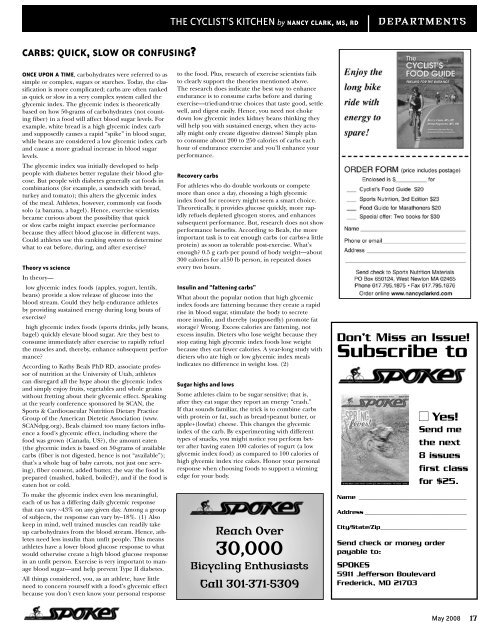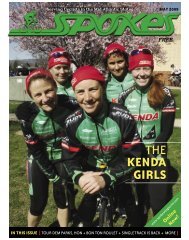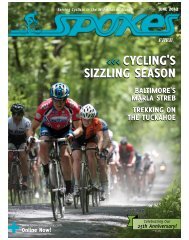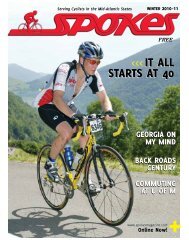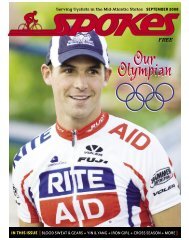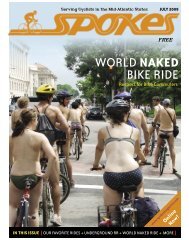Race Across America? - Spokes Magazine
Race Across America? - Spokes Magazine
Race Across America? - Spokes Magazine
Create successful ePaper yourself
Turn your PDF publications into a flip-book with our unique Google optimized e-Paper software.
THE CYCLIST'S KITCHEN by NANCY CLARK, MS, RD<br />
DEPARTMENTS<br />
CARBS: QUICK, SLOW OR CONFUSING?<br />
ONCE UPON A TIME, carbohydrates were referred to as<br />
simple or complex, sugars or starches. Today, the classification<br />
is more complicated; carbs are often ranked<br />
as quick or slow in a very complex system called the<br />
glycemic index. The glycemic index is theoretically<br />
based on how 50-grams of carbohydrates (not counting<br />
fiber) in a food will affect blood sugar levels. For<br />
example, white bread is a high glycemic index carb<br />
and supposedly causes a rapid “spike” in blood sugar,<br />
while beans are considered a low glycemic index carb<br />
and cause a more gradual increase in blood sugar<br />
levels.<br />
The glycemic index was initially developed to help<br />
people with diabetes better regulate their blood glucose.<br />
But people with diabetes generally eat foods in<br />
combinations (for example, a sandwich with bread,<br />
turkey and tomato); this alters the glycemic index<br />
of the meal. Athletes, however, commonly eat foods<br />
solo (a banana, a bagel). Hence, exercise scientists<br />
became curious about the possibility that quick<br />
or slow carbs might impact exercise performance<br />
because they affect blood glucose in different ways.<br />
Could athletes use this ranking system to determine<br />
what to eat before, during, and after exercise?<br />
Theory vs science<br />
In theory—<br />
low glycemic index foods (apples, yogurt, lentils,<br />
beans) provide a slow release of glucose into the<br />
blood stream. Could they help endurance athletes<br />
by providing sustained energy during long bouts of<br />
exercise?<br />
high glycemic index foods (sports drinks, jelly beans,<br />
bagel) quickly elevate blood sugar. Are they best to<br />
consume immediately after exercise to rapidly refuel<br />
the muscles and, thereby, enhance subsequent performance?<br />
According to Kathy Beals PhD RD, associate professor<br />
of nutrition at the University of Utah, athletes<br />
can disregard all the hype about the glycemic index<br />
and simply enjoy fruits, vegetables and whole grains<br />
without fretting about their glycemic effect. Speaking<br />
at the yearly conference sponsored by SCAN, the<br />
Sports & Cardiovascular Nutrition Dietary Practice<br />
Group of the <strong>America</strong>n Dietetic Association (www.<br />
SCANdpg.org), Beals claimed too many factors influence<br />
a food’s glycemic effect, including where the<br />
food was grown (Canada, US?), the amount eaten<br />
(the glycemic index is based on 50-grams of available<br />
carbs (fiber is not digested, hence is not “available”);<br />
that’s a whole bag of baby carrots, not just one serving),<br />
fiber content, added butter, the way the food is<br />
prepared (mashed, baked, boiled?), and if the food is<br />
eaten hot or cold.<br />
To make the glycemic index even less meaningful,<br />
each of us has a differing daily glycemic response<br />
that can vary ~43% on any given day. Among a group<br />
of subjects, the response can vary by~18%. (1) Also<br />
keep in mind, well trained muscles can readily take<br />
up carbohydrates from the blood stream. Hence, athletes<br />
need less insulin than unfit people. This means<br />
athletes have a lower blood glucose response to what<br />
would otherwise create a high blood glucose response<br />
in an unfit person. Exercise is very important to manage<br />
blood sugar—and help prevent Type II diabetes.<br />
All things considered, you, as an athlete, have little<br />
need to concern yourself with a food’s glycemic effect<br />
because you don’t even know your personal response<br />
to the food. Plus, research of exercise scientists fails<br />
to clearly support the theories mentioned above.<br />
The research does indicate the best way to enhance<br />
endurance is to consume carbs before and during<br />
exercise—tried-and-true choices that taste good, settle<br />
well, and digest easily. Hence, you need not choke<br />
down low glycemic index kidney beans thinking they<br />
will help you with sustained energy, when they actually<br />
might only create digestive distress! Simply plan<br />
to consume about 200 to 250 calories of carbs each<br />
hour of endurance exercise and you’ll enhance your<br />
performance.<br />
Recovery carbs<br />
For athletes who do double workouts or compete<br />
more than once a day, choosing a high glycemic<br />
index food for recovery might seem a smart choice.<br />
Theoretically, it provides glucose quickly, more rapidly<br />
refuels depleted glycogen stores, and enhances<br />
subsequent performance. But, research does not show<br />
performance benefits. According to Beals, the more<br />
important task is to eat enough carbs (or carbs+a little<br />
protein) as soon as tolerable post-exercise. What’s<br />
enough? 0.5 g carb per pound of body weight—about<br />
300 calories for a150 lb person, in repeated doses<br />
every two hours.<br />
Insulin and “fattening carbs”<br />
What about the popular notion that high glycemic<br />
index foods are fattening because they create a rapid<br />
rise in blood sugar, stimulate the body to secrete<br />
more insulin, and thereby (supposedly) promote fat<br />
storage? Wrong. Excess calories are fattening, not<br />
excess insulin. Dieters who lose weight because they<br />
stop eating high glycemic index foods lose weight<br />
because they eat fewer calories. A year-long study with<br />
dieters who ate high or low glycemic index meals<br />
indicates no difference in weight loss. (2)<br />
Sugar highs and lows<br />
Some athletes claim to be sugar sensitive; that is,<br />
after they eat sugar they report an energy “crash.”<br />
If that sounds familiar, the trick is to combine carbs<br />
with protein or fat, such as bread+peanut butter, or<br />
apple+(lowfat) cheese. This changes the glycemic<br />
index of the carb. By experimenting with different<br />
types of snacks, you might notice you perform better<br />
after having eaten 100 calories of yogurt (a low<br />
glycemic index food) as compared to 100 calories of<br />
high glycemic index rice cakes. Honor your personal<br />
response when choosing foods to support a winning<br />
edge for your body.<br />
Reach Over<br />
30,000<br />
Bicycling Enthusiasts<br />
Call 301-371-5309<br />
Don’t Miss an Issue!<br />
Subscribe to<br />
Name ___________________________________<br />
Address _________________________________<br />
City/State/Zip ____________________________<br />
Send check or money order<br />
payable to:<br />
SPOKES<br />
5911 Jefferson Boulevard<br />
Frederick, MD 21703<br />
■ Yes!<br />
Send me<br />
the next<br />
8 issues<br />
first class<br />
for $25.<br />
May 2008<br />
17


